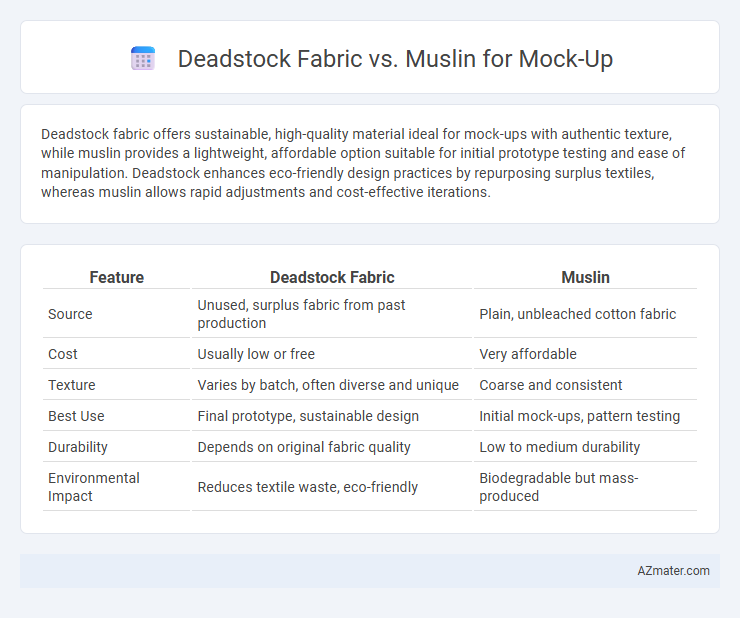Deadstock fabric offers sustainable, high-quality material ideal for mock-ups with authentic texture, while muslin provides a lightweight, affordable option suitable for initial prototype testing and ease of manipulation. Deadstock enhances eco-friendly design practices by repurposing surplus textiles, whereas muslin allows rapid adjustments and cost-effective iterations.
Table of Comparison
| Feature | Deadstock Fabric | Muslin |
|---|---|---|
| Source | Unused, surplus fabric from past production | Plain, unbleached cotton fabric |
| Cost | Usually low or free | Very affordable |
| Texture | Varies by batch, often diverse and unique | Coarse and consistent |
| Best Use | Final prototype, sustainable design | Initial mock-ups, pattern testing |
| Durability | Depends on original fabric quality | Low to medium durability |
| Environmental Impact | Reduces textile waste, eco-friendly | Biodegradable but mass-produced |
Introduction to Mock-Up Fabrics
Deadstock fabric offers a sustainable option for mock-ups by utilizing unused or surplus textile stock, reducing waste and production costs. Muslin, a lightweight and inexpensive cotton fabric, remains a traditional favorite for prototyping due to its easy manipulation and breathability. Both fabrics serve distinct purposes in the design process, with deadstock providing unique textures and sustainability, while muslin offers versatility and affordability.
What Is Deadstock Fabric?
Deadstock fabric refers to unused, leftover textile material from previous production runs, often originally intended for fashion collections or manufacturing purposes but never sold or utilized. It offers unique sustainability benefits by reducing waste and repurposing quality fabric that might otherwise remain dormant in warehouses. Compared to muslin, deadstock fabric typically presents a wide variety of textures, patterns, and fiber contents, making it ideal for designers seeking authentic, eco-conscious mock-up materials with more diverse aesthetic options.
What Is Muslin?
Muslin is a plain-woven cotton fabric commonly used in fashion design for creating mock-ups or test garments due to its lightweight and breathable properties. Unlike deadstock fabric, which is leftover or surplus textile from previous production, muslin offers consistent quality and texture, making it ideal for draping and fitting adjustments. Its affordability and ease of manipulation allow designers to perfect patterns before cutting into final, often more expensive, materials.
Key Differences Between Deadstock and Muslin
Deadstock fabric consists of unused, leftover textiles from previous production runs, often featuring unique patterns and high-quality materials ideal for realistic mock-ups with final garment feel. Muslin, typically a plain-woven cotton fabric, is inexpensive and commonly used for initial fittings and design testing due to its affordability and ease of manipulation. The key difference lies in deadstock fabric providing a more accurate representation of the final product's texture and drape, while muslin prioritizes cost-effectiveness and flexibility during early prototyping stages.
Cost Comparison: Deadstock vs Muslin
Deadstock fabric typically offers a cost-effective option due to its availability as leftover or surplus material from previous production runs, often sold at lower prices than new fabrics. Muslin, while affordable and widely used for mock-ups, generally incurs consistent costs as it is specifically produced for prototyping and testing. Choosing deadstock can reduce expenses significantly when prioritizing budget-friendly options without compromising the testing phase.
Environmental Impact of Fabric Choices
Deadstock fabric reduces environmental waste by repurposing surplus textiles that would otherwise be discarded, significantly lowering landfill contributions and limiting the need for new resource-intensive fabric production. Muslin, often produced with organic cotton options, offers a biodegradable and renewable choice but its cultivation can involve considerable water and pesticide use, impacting ecosystems. Choosing deadstock fabric for mock-ups promotes circular fashion practices, while muslin supports biodegradability, making both viable eco-conscious options depending on the sourcing and production methods.
Working with Deadstock for Mock-Ups
Deadstock fabric provides a sustainable and cost-effective option for mock-ups by repurposing unused textile stock, reducing waste and minimizing material expenses. This fabric often features authentic textures and diverse patterns, offering designers a realistic preview of the final garment's look and feel. Working with deadstock for mock-ups demands thorough inspection for quality and consistency to ensure accurate fitting and construction before production.
Advantages of Using Muslin for Prototypes
Muslin offers a cost-effective and readily available fabric choice for mock-ups, allowing designers to test garment fit and construction without high expenses. Its lightweight and breathable texture provides accurate drape and ease of manipulation, facilitating quick adjustments during prototype development. Utilizing muslin reduces fabric waste and accelerates the iteration process, making it ideal for refining designs before final production.
Fabric Availability and Sourcing
Deadstock fabric offers limited availability as it consists of surplus or leftover materials from previous production runs, making sourcing inconsistent and often time-sensitive. Muslin, widely used in mock-ups, is readily accessible through numerous fabric suppliers with consistent quality and bulk purchasing options. Designers sourcing materials for prototypes often prefer muslin for its dependable supply and ease of acquisition compared to the sporadic nature of deadstock fabric.
Which Fabric Should You Choose for Your Next Mock-Up?
Deadstock fabric offers sustainable, often high-quality material perfect for accurate garment mock-ups, ensuring precise drape and texture replication without additional environmental impact. Muslin, a cost-effective, breathable cotton fabric, provides an ideal surface for initial pattern testing and fit adjustments due to its consistent weave and wide availability. Choosing between deadstock fabric and muslin depends on whether the mock-up requires eco-conscious authenticity or economical, easy-to-handle testing material.

Infographic: Deadstock Fabric vs Muslin for Mock-up
 azmater.com
azmater.com